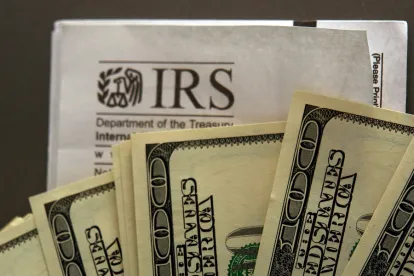On October 7, 2020, the U.S. Internal Revenue Service (“IRS”) and Treasury Department released final regulations[1] providing guidance on the rules imposing withholding and reporting requirements under the Code[2] on dispositions of certain partnership interests by non-U.S. persons (the “Final Regulations”). The Final Regulations expand and modify proposed regulations[3] that were published on May 13, 2019 (the “Proposed Regulations”), and which we described in a prior Tax Talks post.[4] Unless otherwise specified, this post focuses on the differences between the Proposed Regulations and the Final Regulations affecting transfers of interests in non-publicly traded partnerships.
Enacted as part of the “Tax Cuts and Jobs Act,” Section 1446(f) generally requires a transferee, in connection with the disposition of a partnership interest by a non-U.S. person, to withhold and remit ten percent of the “amount realized” by the transferor, if any portion of any gain realized by the transferor on the disposition would be treated under Section 864(c)(8) as effectively connected with the conduct of a trade or business in the United States (“Section 1446(f) Withholding”).[5]
Prior to issuing the Proposed Regulations, the IRS had issued Notice 2018-08 and Notice 2018-29 to provide interim guidance with respect to Section 1446(f) Withholding.
Executive Summary
The Final Regulations make several changes to the Proposed Regulations, some of which are taxpayer-friendly, including:
-
new certifications to confirm the applicability of certain exceptions to Section 1446(f) Withholding (which should facilitate certain secondary transfers of partnership interests), and confirming which exceptions look to gross income and which exceptions look to net income;
-
clarifying that partnerships may rely on a valid Form W-9 for the transferor to determine that an applicable exception to Section 1446(f) Withholding is satisfied;
-
allowing transferees to directly claim refunds for excess secondary withholding by a partnership (rather than requiring the partnership itself to apply for such refunds); and
-
allowing tax treaty benefits to be taken into account in limited circumstances to reduce or eliminate Section 1446(f) Withholding.
The Final Regulations also clarify some prior ambiguities, including:
-
the IRS and Treasury Department’s expansive interpretation of the scope of Section 1446(f) Withholding;
-
the affirmative obligation imposed on partnerships (as part of their secondary withholding obligations) to ensure the appropriate amounts are withheld; and
-
clarifying that if an applicable exception to Section 1446(f) Withholding is satisfied at the time of the initial transfer, subsequent earnout payments will not be subject to Section 1446(f) Withholding.
I. Applicability Dates
The Final Regulations applicable to reporting regarding transfers of interests in partnerships engaged in a U.S. trade or business (“Specified Partnerships”) are generally effective when published. The rules requiring a non-U.S. transferor of an interest in a Specified Partnership to notify the Specified Partnership of the transfer apply to transfers that occur on or after the date the Final Regulations are formally published. Similarly, a Specified Partnership’s reporting obligation regarding realized gain effectively connected with a U.S. trade or business when the Specified Partnership is aware of a non-U.S. transferor applies to all tax returns filed on or after the date the Final Regulations are formally published.
Most of the Final Regulations applicable to Section 1446(f) Withholding will apply to all transfers of partnership interests that occur on or after the date which is 60 days or more after the date the Final Regulations are formally published. For transfers that occur before that date, taxpayers may continue to choose to apply the withholding rules described in either Notice 2018-29 or the Proposed Regulations.
However, in all events, secondary withholding liability for partnerships will apply only to transfers that occur on or after January 1, 2022.
Takeaway: As publication is expected any day, it is anticipated that the Final Regulations for Section 1446(f) Withholding will be in effect for year-end transfers (however, partnerships will not be secondarily liable for withholding with respect to any transfers that occur prior to 2022). Partnerships should anticipate additional diligence and certification requests from transferring parties as a consequence of the Final Regulations.
II. Changes to Exceptions to Section 1446(f) Withholding
a. Partner-Level Ten Percent ECI Exception
Under the Proposed Regulations, no Section 1446(f) Withholding is required if a transferor provides a certification that its allocable share of effectively connected taxable income (“ECTI”) from the partnership for each of its three preceding tax years was less than $1 million and less than ten percent of the transferor’s total distributive share of net income from the partnership for that tax year. Under Notice 2018-29 and the Proposed Regulations, the allocable share of ECTI for each tax year was the value provided on the applicable Form 8805, with any allocable share of effectively connected taxable loss (“ECTL”) treated as zero ECTI, but some funds are structured so that partners receive no ECTI or ECTL, in which case the transferor could not provide this certification.
By contrast, the Final Regulations look to gross income to determine whether the transferor’s distributive share of gross effectively connected income from the partnership for each of the three preceding tax years was less than $1 million and less than ten percent of the transferor’s total distributive share of gross income from the partnership for that tax year. Importantly, this certification no longer requires a Form 8805 for any preceding tax year.
The new formula, however, does require the transferor to be allocated some gross income in each of the three preceding tax years. This requirement could be a problem for transferors of interests in partnerships such as certain “alternative investment vehicles” whose activities are limited solely to owning stock of corporations that may not generate allocable income in some tax years.
Takeaway: The modification may make it easier for transferors who have not received Forms 8805 from the partnership or who were allocated a net loss in any of the three preceding tax years to claim the Partner-Level Ten Percent ECI Exception. However, the use of gross values may make it more difficult to meet the $1 million and ten percent tests for the certification. Overall, the “de minimis” Section 1446(f) Withholding exceptions provided in the Final Regulations seem to respond to taxpayer concerns that the requirements set forth in prior guidance to meet those exceptions were burdensome to administer.
b. Partner-Level No Realized Gain Exception
Section 1446(f) Withholding is generally not required where a transferor certifies that no gain will be realized on the disposition of a partnership interest. Under the Proposed Regulations, the IRS clarified that this took into account recognition of ordinary income under Section 751, and therefore Section 1446(f) Withholding would be required if there would be ordinary income under Section 751 even where there was an overall effectively connected loss determined under Section 741 (prior to the application of Section 751). Recognizing that a transferor may not always know at the time of transfer whether it will realize Section 751(a) income, the Final Regulations allow the transferor to rely on a certification from the partnership that, as of the determination date,[6] the transfer would not result in any Section 751 income to the transferor.
Takeaway: This new Section 751(a) certification may make it easier to claim the Partner-Level No Realized Gain Exception provided that partnerships are willing and able to certify to the lack of Section 751 gain allocable to the transferor as of the determination date.
c. Partnership-Level Ten Percent Effectively Connected Gain Exception
Consistent with the Proposed Regulations, no Section 1446(f) Withholding is required if a partnership provides the transferee a certification stating that if the partnership sold all of its assets at fair market value on the determination date (the “Deemed Sale”), the partnership would either not have gain effectively connected to a U.S. trade or business (including gain attributable to U.S. real property interests (“USRPIs”)) (“Effectively Connected Gain”) or that such Effectively Connected Gain would be less than ten percent of the total net gain.
In addition, the Final Regulations have expanded the certification options with two additional certifications that the partnership can provide so that a transfer qualifies for this exception.
I. No Distributive Share of Effectively Connected Gain Certificate
The transferee may rely on a certification from the partnership that, for the Deemed Sale, the transferor would either not have a distributive share of net Effectively Connected Gain from the partnership (including gain attributable to USRPIs) or that such share would be less than ten percent of the transferor’s distributive share of the total net gain from the partnership.
Takeaway: By allowing the partnership to make the determination as of the determination date looking to either all of the partnership’s tax items or just those in the transferor’s distributive share, the Final Regulations provide additional flexibility, including covering transfers where there is no Effectively Connected Gain or effectively connected loss.
II. No U.S. Trade or Business Certificate
The transferee may rely on a certification from the partnership that the partnership was not engaged in a U.S. trade or business during the partnership’s tax year through the date of transfer. A partnership that has USRPIs that are not part of a trade or business, such as stock in a “U.S. real property holding corporation,” and no other Effectively Connected Gain resulting from the Deemed Sale may provide this certification, ensuring that Section 1446(f) Withholding is not imposed by reason of the USRPIs alone.
Takeaway: While most partnerships that could provide this certificate could also provide the other certificates for this exception (as the absence of a U.S. trade or business will normally result in no net Effectively Connected Gain from a Deemed Sale), this certificate will allow exceptions from Section 1446(f) Withholding on transfers of interests in partnerships whose only net Effectively Connected Gain would come from USRPIs.
III. Changes to Secondary Withholding Liability
If a transferee does not withhold the amount required with respect to a transfer of an interest in a partnership, Section 1446(f)(4) requires that partnership to withhold the underwithheld amount plus interest from future distributions to the transferee. This secondary withholding liability will apply to transfers occurring on or after January 1, 2022.
a. Valid W-9 Exception
The Final Regulations provide that a partnership does not have to withhold on distributions to a transferee under Section 1446(f)(4) if the partnership possesses a valid Form W-9 (or other certification of non-foreign status) for the transferor unless the partnership has reason to know it is incorrect or unreliable.
Takeaway: As expected, a partnership holding a valid Form W-9 for a transferor may rely on that Form W-9 to determine its lack of secondary withholding liability, unless for some reason the transferor provides an inconsistent certification of non-foreign status to the transferee.
b. Affirmative Obligation to Withhold
The preamble to the Final Regulations confirms that partnerships do not have to rely on certifications from transferring parties when determining whether the transferee failed to withhold the appropriate amount. This discretion reinforces the affirmative obligation of the partnership to determine the proper amount of Section 1446(f) Withholding.
Takeaway: Partnerships that are engaged in a U.S. trade or business may wish to take a more proactive approach to determining that transfers involving non-U.S. transferors comply with withholding requirements. This discretion may require a more thorough review by partnerships as to the determination of amounts withheld in transfers. Partnerships should require indemnification for secondary withholding in their operating agreements and transfer agreements.
c. Refunds of Excess Secondary Withholding
Under the Proposed Regulations, where the amount withheld by the partnership exceeded the transferee’s Section 1446(f) Withholding, only the partnership could file for a refund of the excess withholding. The Final Regulations now allow the transferee to claim such a refund.
Takeaway: By allowing transferees as well as partnerships to recover refunds of excess secondary withholding, there may be more opportunities to claim such refunds—co-operation between the transferee and partnership will still be required.
IV. Other Changes
a. Clarification of the Scope of Section 1446(f) Withholding
Under the Proposed Regulations there had been uncertainty as to whether Section 1446(f) Withholding was always required in the absence of a certificate establishing an exception from withholding. The Final Regulations provide some relief by creating a presumption that where there is no gain under Section 864(c)(8) (which can be established by showing that the transferor is a U.S. person (including a U.S. partnership) or that the partnership is not engaged in a U.S. trade or business and has no assets that would give rise to Effectively Connected Gain), there is no liability for either the partnership or the transferee. Therefore, even in the absence of a certificate at the time of the transfer, a taxpayer will not be liable for interest, penalties or additions to the underwithheld tax if the taxpayer establishes that the transferor had no gain under Section 864(c)(8).
Takeaway: Partnerships, transferors and transferees will want to work together to ensure the proper amount is withheld, particularly for transfers occurring after 2021.
b. Use of Treaties
The Proposed Regulations provided procedures to reduce or eliminate the amount of Section 1446(f) Withholding through limited use of tax treaties, which allowed non-U.S. transferors that were eligible to claim tax treaty benefits in certain circumstances.
The Final Regulations retain this approach, except that non-U.S. partnership transferors providing a certification of modified amount realized may now also look through to the tax treaty qualifications of their owners to calculate the modified amount realized.
Takeaway: As many non-U.S. partnerships may not themselves be treaty qualified in their home jurisdictions, the look-through rule for the certification of modified amount realized may expand the number of situations in which treaties apply to reduce Section 1446(f) Withholding.
c. Disguised Sales of Partnership Interests
The preamble to the Final Regulations confirms that disguised sales of partnership interests under Section 707(a)(2)(B) are subject to Section 1446(f) Withholding but note that further guidance on what constitutes a disguised sale of a partnership interest in this context is outside the scope of the rulemaking.
Takeaway: Partnerships should be mindful of this issue when considering the implications of multiple closings.
d. Earnout Payments
The preamble to the Final Regulations confirms that, pursuant to Treasury Regulations Section 1.1446(f)-2, if a transfer qualifies for an exception to Section 1446(f) Withholding at the time of the transfer, the exception will apply to any future payments related to the transfer, including earnout payments.
Takeaway: If a transfer is exempt from Section 1446(f) Withholding, future payments related to the transfer will also be exempt.
_______________________
[1] https://www.irs.gov/pub/irs-drop/td-9926.pdf
[2] All references to the Code are to the United States Internal Revenue Code of 1986, as amended.
[3] https://www.federalregister.gov/documents/2019/05/13/2019-09515/withholding-of-tax-and-information-reporting-with-respect-to-interests-in-partnerships-engaged-in
[4] https://www.proskauertaxtalks.com/2019/05/section-1446f-proposed-regulations-key-guidance-on-partnership-interest-transfers-by-non-u-s-persons/
[5] For further discussion of Sections 864(c)(8) and 1446(f), please see our prior coverage. In very general terms, Section 864(c)(8) is intended to codify the IRS’s longstanding position on the character of dispositions of certain partnership interests by non-U.S. persons. See Rev. Rul. 91-32, 1991-1 C.B. 107.
[6] Consistent with the Proposed Regulations, taxpayers may select a determination date that can be used, instead of the date of transfer, to make certain withholding determinations.






 />i
/>i

